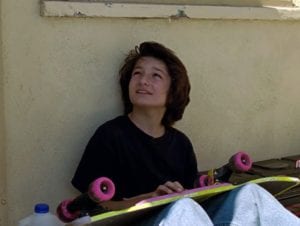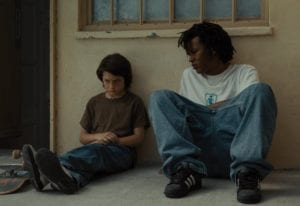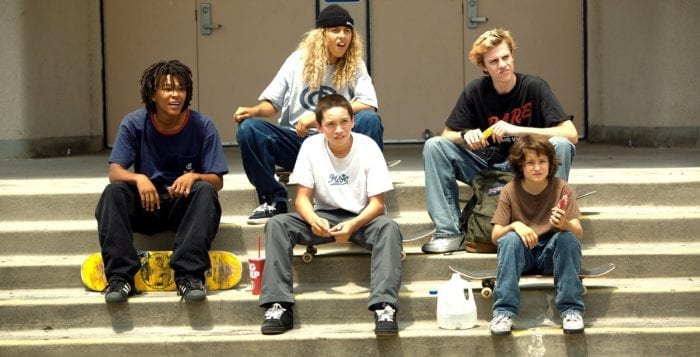Movie Review: ‘Mid90s’ is a new kind of nostalgia
By Kyle Barr
The real question with films like “Mid90s” and other throwbacks to the days of the childhoods of those born in the ’80s and ’90s is really how far you can get with callbacks and brand recognition.
It has worked well in some places, such as with the hit Netflix show “Stranger Things,” but a movie still needs a storyline to fill out the space left between brand name dropping and scenes of, “Oh, don’t you remember this? Wasn’t this fun?” Well, “Mid90s,” which opened in theaters Oct. 21, is an interesting take on nostalgia, one that shows the ugly sides of childhood without any kind of judgment.

“Mid90s” takes place in Los Angeles during the titular 1990s as the California skating scene was at its peak. Young Stevie (Sunny Suljic) lives in a dysfunctional house with abusive older brother Ian (Lucas Hedges) and his co-dependent mom Dabney (Katherine Waterston). While riding his bike Stevie sees a young group of skaters at a distance and decides to infiltrate that friend group, despite the fact he has never ever skated in his life. The skaters, made up of pro-skater hopeful Ray (Na-kel Smith), party-hopper F**** (Olan Prenatt), lonely Ruben (Gio Galicia) and the reserved filmmaker Fourth Grade (Ryder McLaughlin), start taking a liking to the young kid, who they nickname Sunscreen.
Stevie, while learning to skate, also falls into the seedier elements of the scene, the ones involving drugs and alcohol. He picks up terrible habits, acting out against his family. His friends are tested even harder when it becomes evident Ray is coming closer and closer to becoming pro, potentially leaving all those who look up to him behind.
It’s a movie called “Mid90s,” so it’s obvious that first-time director Jonah Hill, most known for his roles in films like “The Wolf of Wall Street,” is trying to make some kind of declaration of this time period. Unlike something like “Stranger Things,” the brands, music and albums so notorious from the era aren’t just set dressing but are integral to the theme. Stevie goes into his brother’s room and looks through his music, full of recognizable band names, just so he could give him a birthday gift in the next scene, which he then tosses on the table like he’s just received rotten fruit. The recognizable posters on Stevie’s wall are swapped out later once he starts to love the skating culture.

But what really drives the film’s forward momentum is the intense theme of skating as a relief from home life. Though it’s not so much an escape from problems, skating is shown as a way to connect with people on a deep spiritual level. It’s revealed relatively late in the film how each of the main characters has an imperfect home life, and that the friendship they have with each other is what keeps them all sane.
Though it’s not a long movie, running at about the 90-minute mark, Hill doesn’t make this film overstay its welcome. That’s not to say there aren’t moments that makes one think this is a first-time directorial effort, small sequences that don’t add up, camerawork that pushes in a little too close to faces and a few other niggling details.
The film is also explicit in a number of ways, some of which involve the main character who is supposedly 13 years old, according to the film. Be sure to come at this flick without a sense of judgment for the characters, as the film itself makes it plain it doesn’t wish to judge them as well.
I was never a skater as a kid, but I knew those who were. Even if you have some sort of interest to dive into a time and place that few can honestly say they were a part of, then “Mid90s” should be a good run of some vicarious nostalgia.
Rated R for pervasive language, sexual content, drug and alcohol use and violence, “Mid90s” is now playing in local theaters.







